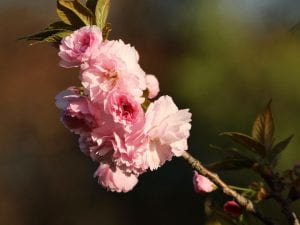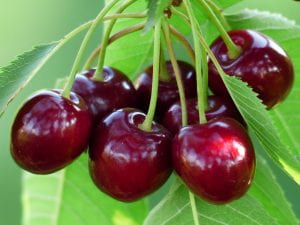By Sharon Lunden, Goshen Master Gardener Volunteer
This article appeared in the February 2021 Issue of Gardening in Orange County.
This month we honor two great presidents, Abraham Lincoln and George Washington. Stories circulate about each of them chopping trees in their youth. Images of young Lincoln frequently show an axe in his hands, and we’ve all heard the legend of six-year-old George Washington chopping down his father’s cherry tree, confessing, “I cannot tell a lie . . . I did cut it with my hatchet.”

What do you think of when you hear “cherry tree”? Perhaps the cherry blossoms surrounding the tidal basin in Washington, D.C. They have gorgeous white and pink blooms that fragrance the air each spring. Did you know there are more than a dozen varieties of cherry tree throughout our nation’s capital? Japan gave 3020 of these trees to the United States in 1912, as a gesture of friendship. Most were Yoshino cherry trees, Prunus x yedoensis, blooming in clusters of single white flowers with an almond scent, and developing small cherries that attract birds.

Another variety sent from Japan is the fruitless Kwanzan cherry, Prunus serrulata. ‘Kwanzan’ produces pink double blooms. Both varieties of cherry tree can be planted in our area. They are hardy in zones up to 5b, and they develop pretty fall foliage. They are relatively short (15–20 feet tall), and short-lived (up to 20 years), but they are so lovely, many gardeners consider them worth the effort. Cherry blossom festivals are held throughout the United States in spring, a testament to our devotion to these gorgeous trees.
Perhaps you’ve seen a Weeping Higan cherry, Prunus x subhirtella (‘Pendula’) in a neighbor’s garden. These grow up to 40 feet tall and produce pretty pink double blossoms on their branches. They can be trimmed for easy mowing or gardening closer to their trunks, or allowed to droop to the ground—in which case you’d need to plant around their drip line to incorporate them into a flower bed.
Ornamental cherries are non-natives and can be susceptible to disease and insect infestation, so they may require regular attention.

Native cherries, or black cherries, Prunus serotina, stand in stark contrast to their ornamental cousins. These trees tower between 60 and 90 feet and can be found from Nova Scotia to Florida and from coast to coast, in zones 3b–9a. They erupt in pendulous racemes up to 6 inches long, covered in fragrant white flowers in spring. They have shiny foliage throughout the summer, turning to a rosy yellow in the fall. The inside of the bark has been used by Native Americans for cough syrups and medicines. The wood is prized by woodworkers for use in making furniture, cabinetry, gun stocks, and musical instruments. These native cherry trees also produce edible cherries.

We’ve probably all snacked on a bowl of Bing cherries, Prunus avium ‘Bing’, a well-loved variety of sweet cherries. These trees come in both standard (up to 35 feet tall) or dwarf (12–15 feet tall) varieties, and grow in zones 5–8. Bing will take about 5 years to begin producing, but once mature a Bing cherry tree can produce 50–100 lbs. of fruit!
These are just a few of the hundreds of varieties of cherry trees available. Why not consider planting one to delight your eyes as well as your taste buds?
Want more cherry blossoms…
Take a tour of Cherry Blossoms Around the World!
